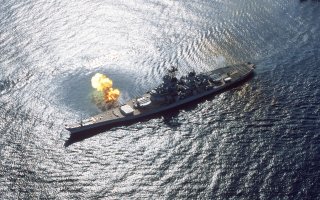The 10 Greatest Naval Battles (and Battleships) of All Time
Back by popular demand, we present two of our most popular pieces.
Battle of Denmark Straits:
When the German battleship Bismarck entered service in 1941, she became the largest warship in the world, displacing the Royal Navy battlecruiser HMS Hood. In May 1941, the Bismarck sortied from Norway in the company of the heavy cruiser Prinz Eugen. The Germans planned to use the pair as commerce raiders, with Bismarck drawing off or destroying the capital ship escorts of any convoys, while Prinz Eugen concentrated on the merchant ships themselves.
The first task force to intercept Bismarck included HMS Hood, HMS Prince of Wales, and four destroyers. HMS Prince of Wales was theoretically comparable to Bismarck, but teething problems (she had only very recently completed trials) limited her combat effectiveness. HMS Hood carried a similar armament to Bismarck (8 15” guns), but also carried twenty more years of age.
Appreciating the threat that long-range fire posed to the thin deck-armor of Hood, Vice Admiral Lancelot Holland sought to close the range as quickly as possible. Unfortunately, Bismarck’s fifth salvo caught Hood amidships, resulting in a huge explosion. Analysts debate to this day what precisely happened aboard Hood, but the blast took her to the bottom so quickly that only three crewmembers (from a crew of 1419) escaped.
Late in the battle, Prince of Wales scored a hit on Bismarck that caused a fuel leak. This killed Bismarck’s mission; she could not raid into the Atlantic with fuel running low. Bismarck broke contact with Prince of Wales (which by this time was severely hampered by gunnery breakdowns), and attempted to run for home. Two days later she was caught by HMS Rodney and HMS King George V, which avenged Hood by sending Bismarck to the bottom.
Second Battle of Guadalcanal:
In late 1942, Americans owned the day over the Solomon Islands, largely by virtue of their control of Henderson Airfield. The Japanese, on the other hand, owned the night. The Imperial Japanese Navy (IJN) used its advantages at night to run supplies and reinforcements to Japanese troops on Guadalcanal, and to bombard American positions.
On November 13, a task force including two Japanese battleships tried to “run the slot” and bombard Henderson. The IJN task force was met by a group of American cruisers and destroyers, which took advantage of surprise and good luck to cripple the battleship Hiei. American aircraft finished off Hiei the next day.
The following evening, the Japanese tried again. The Americans, virtually tapped out after months of grueling combat, went to their aces in the hole; USS Washington and USS South Dakota, a pair of fast battleships normally tasked with escorting carriers. Four destroyers screened the two battleships. The IJN force included the battleship Kirishima (sister of Hiei, and survivor of the first battle), four cruisers, and nine destroyers.
The early stages of the night action saw the IJN warships sweep aside the U.S. Navy destroyer screen. South Dakota and Washington became separated, and the former came under heavy fire from the entire Japanese task force, which caused high casualties and a complete loss of communications. When the Japanese opened up on South Dakota, however, they revealed their position to USS Washington, which took the opportunity to hammer HIJMS Kirishima with her 16” and 5” guns. Kirishima suffered mortal damage, fell out of the battle line, and eventually sank (although most of her crew was rescued). South Dakota and Washington escaped, the latter with virtually no damage.
Parting Salvos:
Only eight dreadnoughts remain, all in the United States. Over time, it is almost certain that this number will dwindle; several of the memorialized battleships are in poor condition, and likely will eventually find their way to the scrappers, or to service as an artificial reef. Nevertheless, for more than a generation analysts and the general public perceived these ships to constitute the currency of naval, and to some extent national, power.
This article first appeared several years ago.
Image: Wikimedia Commons

